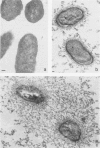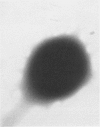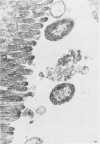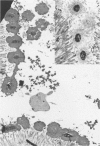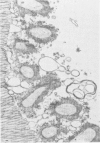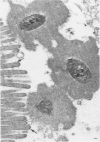Abstract
Electron microscopy was used to study the interaction between the glycocalyx of enterotoxigenic Escherichia coli strain 210 (09:K30+;K99-;F41-:H-) and the glycocalyx of epithelial cells in then ileum of experimentally infected newborn colostrum-deprived calves. Fixation of tissues in anti-K30 antibody and ruthenium red was used to stabilize the bacterial glycocalyx so that the spatial relationship between the bacteria and the intestinal epithelial cells could be characterized.
When strain 210 was grown in vitro and reacted with anti-K30 antibody prior to staining with ruthenium red, the extensive glycocalyx could be clearly visualized surrounding the bacterial cells. By negative staining, an unidentified pilus was also seen. Sections of ileum from infected calves, which were not fixed in antibody nor stained with ruthenium red, revealed attached bacteria which were surrounded by an electron-translucent zone and no visible bacterial glycocalyx. When ruthenium red staining was used, the bacterial glycocalyx partially collapsed during the dehydration steps of fixation, but could be seen as either a fibrous capsule or an electron-dense accretion on the bacterial cell surface. When ileal tissue was reacted for one hour in anti-K30 antibody before staining with ruthenium red, the bacterial glycocalyx was seen as a discrete electron-dense structure up to 1.0µm thick which was in intimate contact with the glycocalyx of the epithelial cells. The importance of the bacterial exopolysaccharide to microcolony formation on the villi could be clearly visualized.
Full text
PDF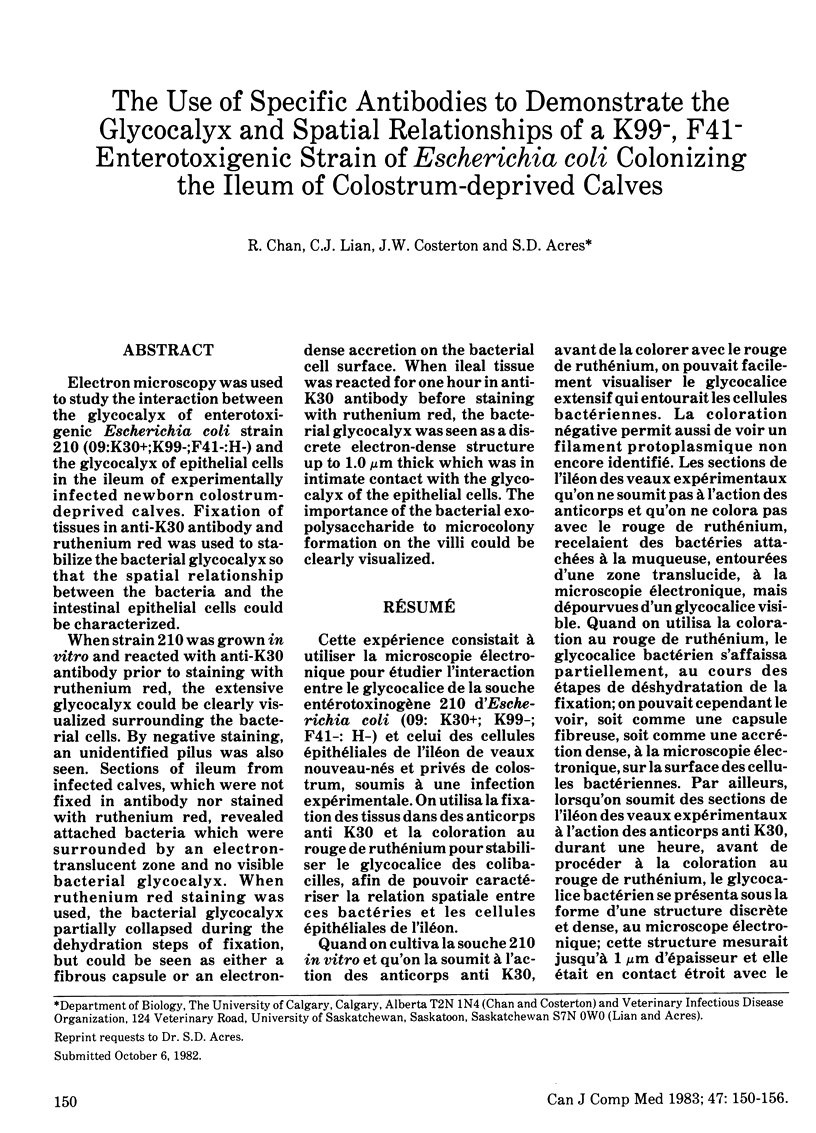
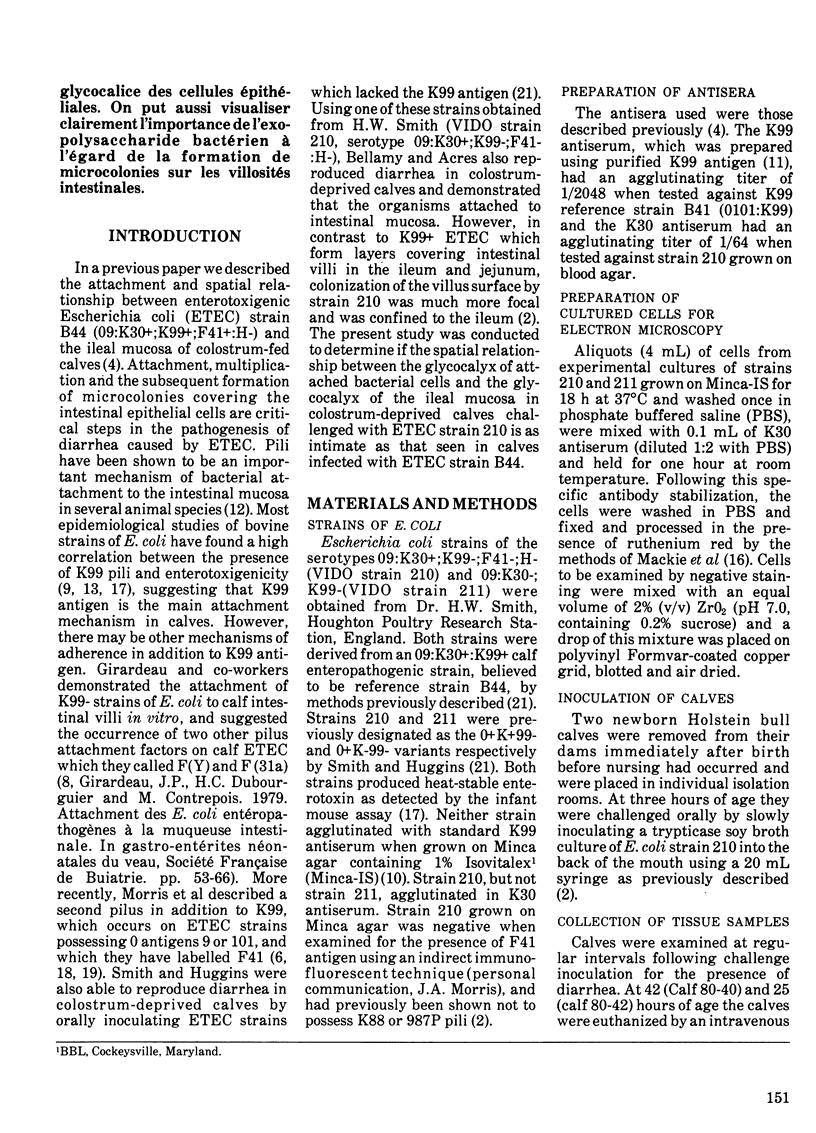
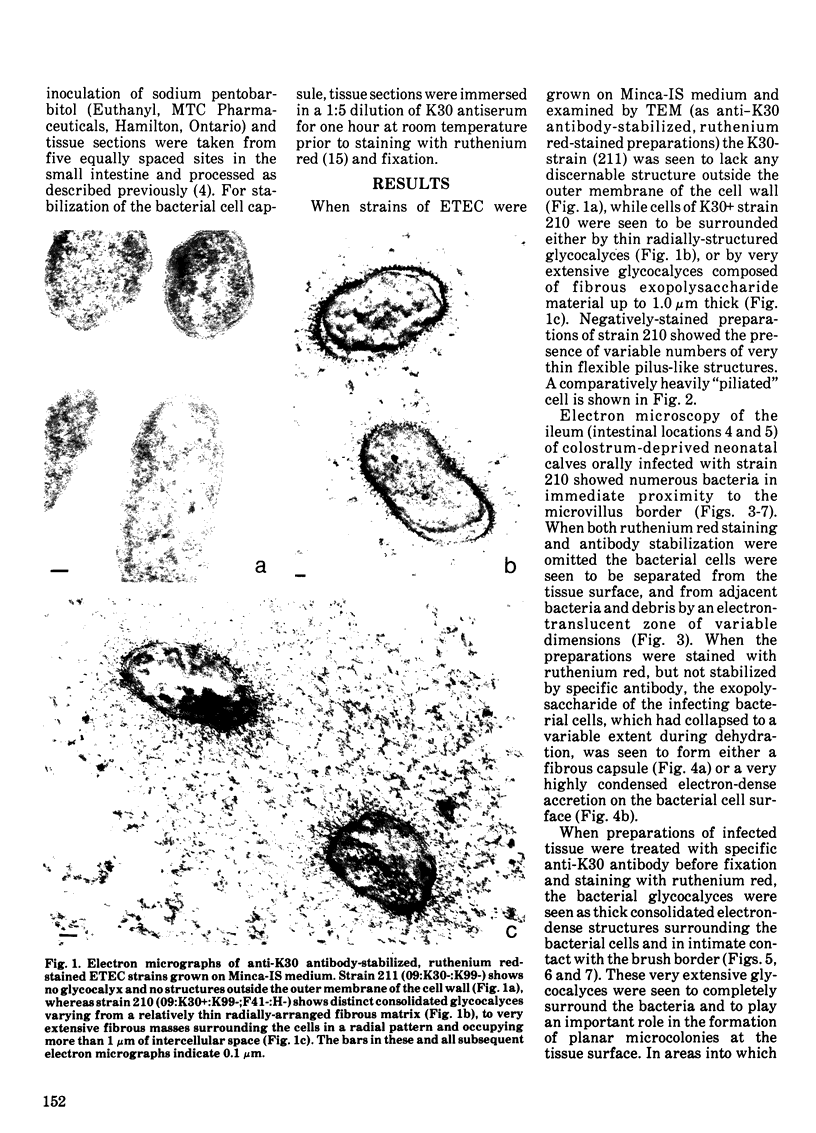
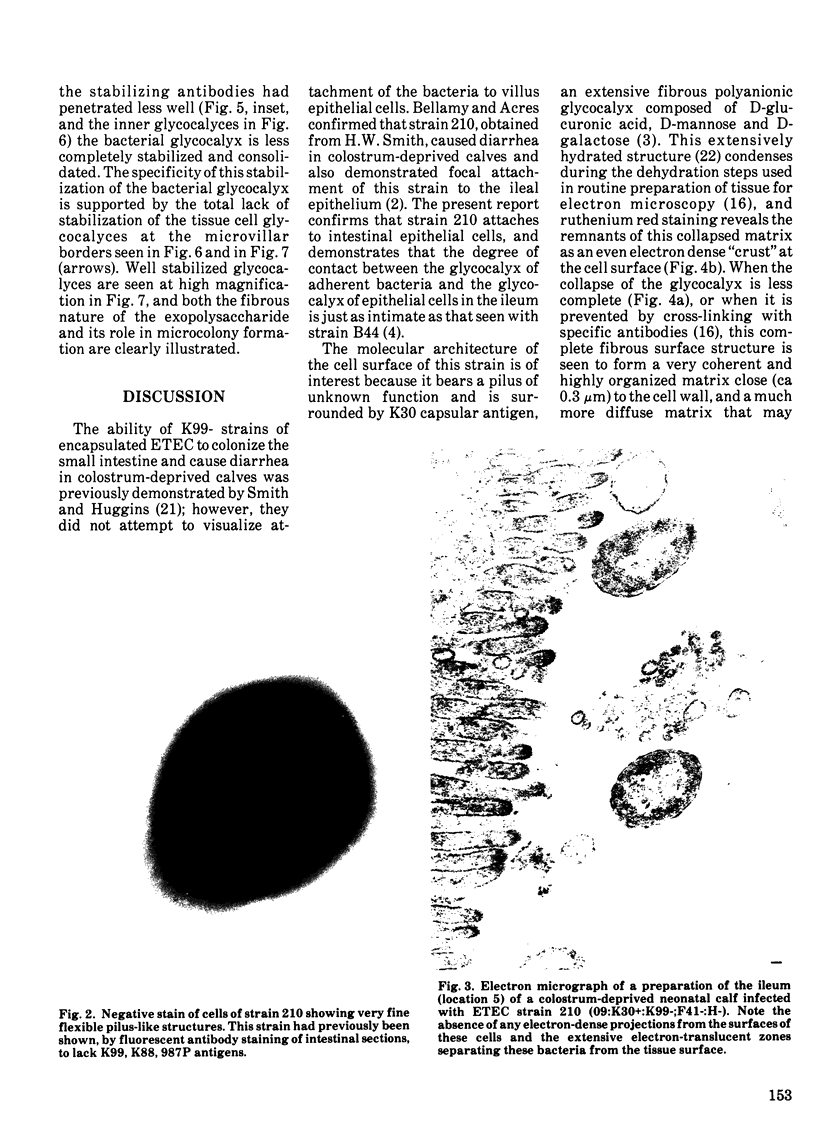

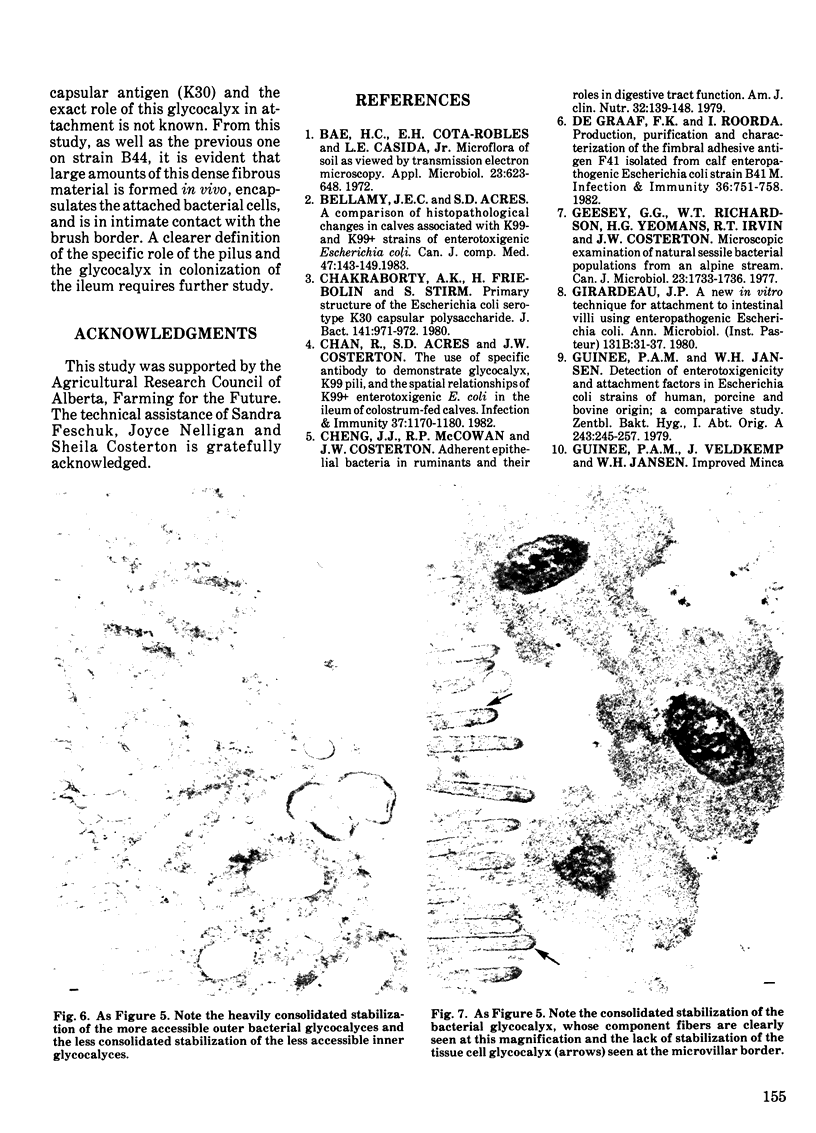
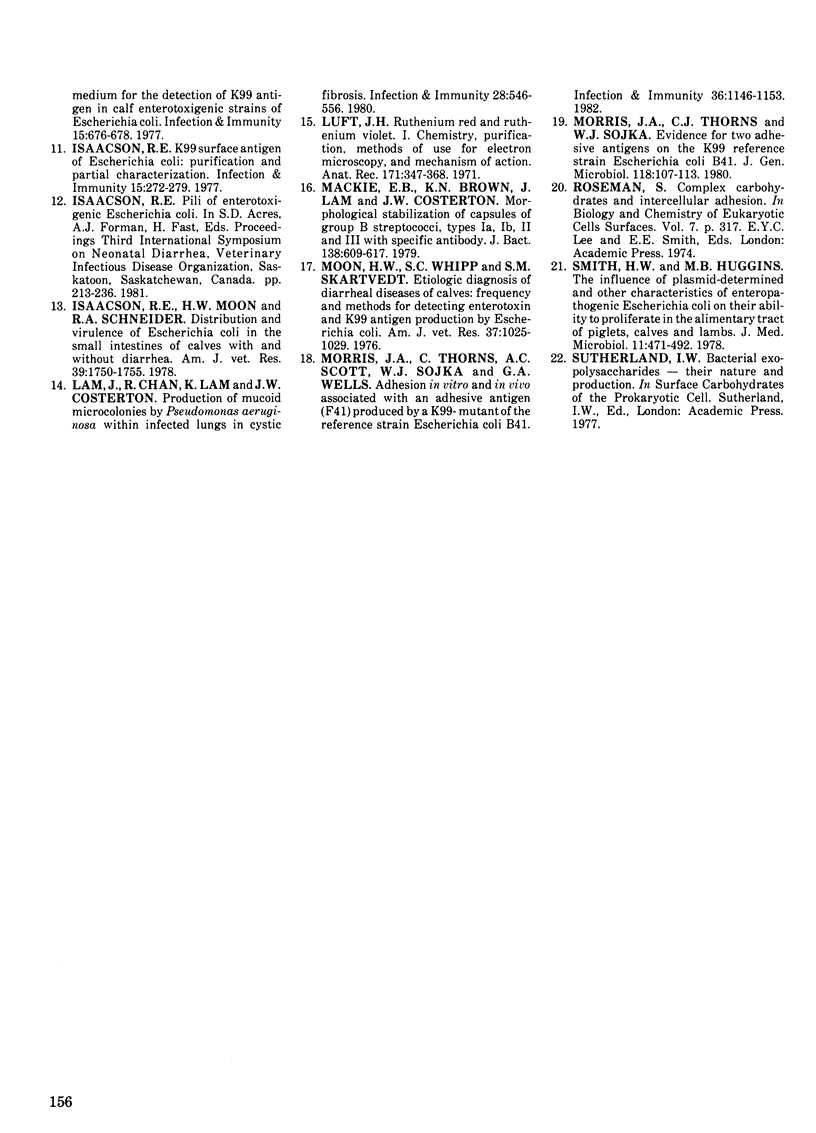
Images in this article
Selected References
These references are in PubMed. This may not be the complete list of references from this article.
- Bae H. C., Cota-Robles E. H., Casida L. E. Microflora of soil as viewed by transmission electron microscopy. Appl Microbiol. 1972 Mar;23(3):637–648. doi: 10.1128/am.23.3.637-648.1972. [DOI] [PMC free article] [PubMed] [Google Scholar]
- Bellamy J. E., Acres S. D. A comparison of histopathological changes in calves associated with K99- and K99+ strains of enterotoxigenic Escherichia coli. Can J Comp Med. 1983 Apr;47(2):143–149. [PMC free article] [PubMed] [Google Scholar]
- Chakraborty A. K., Friebolin H., Stirm S. Primary structure of the Escherichia coli serotype K30 capsular polysaccharide. J Bacteriol. 1980 Feb;141(2):971–972. doi: 10.1128/jb.141.2.971-972.1980. [DOI] [PMC free article] [PubMed] [Google Scholar]
- Chan R., Acres S. D., Costerton J. W. Use of specific antibody to demonstrate glycocalyx, K99 pili, and the spatial relationships of K99+ enterotoxigenic Escherichia coli in the ileum of colostrum-fed calves. Infect Immun. 1982 Sep;37(3):1170–1180. doi: 10.1128/iai.37.3.1170-1180.1982. [DOI] [PMC free article] [PubMed] [Google Scholar]
- Cheng K. J., McCowan R. P., Costerton J. W. Adherent epithelial bacteria in ruminants and their roles in digestive tract function. Am J Clin Nutr. 1979 Jan;32(1):139–148. doi: 10.1093/ajcn/32.1.139. [DOI] [PubMed] [Google Scholar]
- Geesey G. G., Richardson W. T., Yeomans H. G., Irvin R. T., Costerton J. W. Microscopic examination of natural sessile bacterial populations from an alpine stream. Can J Microbiol. 1977 Dec;23(12):1733–1736. doi: 10.1139/m77-249. [DOI] [PubMed] [Google Scholar]
- Girardeau J. P. A new in vitro technique for attachment to intestinal villi using enteropathogenic Escherichia coli. Ann Microbiol (Paris) 1980 Jul-Aug;131B(1):31–37. [PubMed] [Google Scholar]
- Guinée P. A., Jansen W. H. Detection of enterotoxigenicity and attachment factors in Escherichia coli strains of human, porcine and bovine origin; a comparative study. Zentralbl Bakteriol Orig A. 1979 Apr;243(2-3):245–257. [PubMed] [Google Scholar]
- Isaacson R. E. K99 surface antigen of Escherichia coli: purification and partial characterization. Infect Immun. 1977 Jan;15(1):272–279. doi: 10.1128/iai.15.1.272-279.1977. [DOI] [PMC free article] [PubMed] [Google Scholar]
- Isaacson R. E., Moon H. W., Schneider R. A. Distribution and virulence of Escherichia coli in the small intestines of calves with and without diarrhea. Am J Vet Res. 1978 Nov;39(11):1750–1755. [PubMed] [Google Scholar]
- Lam J., Chan R., Lam K., Costerton J. W. Production of mucoid microcolonies by Pseudomonas aeruginosa within infected lungs in cystic fibrosis. Infect Immun. 1980 May;28(2):546–556. doi: 10.1128/iai.28.2.546-556.1980. [DOI] [PMC free article] [PubMed] [Google Scholar]
- Luft J. H. Ruthenium red and violet. I. Chemistry, purification, methods of use for electron microscopy and mechanism of action. Anat Rec. 1971 Nov;171(3):347–368. doi: 10.1002/ar.1091710302. [DOI] [PubMed] [Google Scholar]
- Mackie E. B., Brown K. N., Lam J., Costerton J. W. Morphological stabilization of capsules of group B streptococci, types Ia, Ib, II, and III, with specific antibody. J Bacteriol. 1979 May;138(2):609–617. doi: 10.1128/jb.138.2.609-617.1979. [DOI] [PMC free article] [PubMed] [Google Scholar]
- Moon H. W., Whipp S. C., Skartvedt S. M. Etiologic diagnosis of diarrheal disease of calves: frequency and methods for detecting enterotoxin and K99 antigen production by Escherichia cola. Am J Vet Res. 1976 Sep;37(9):1025–1029. [PubMed] [Google Scholar]
- Morris J. A., Thorns C. J., Sojka W. J. Evidence for two adhesive antigens on the K99 reference strain Escherichia coli B41. J Gen Microbiol. 1980 May;118(1):107–113. doi: 10.1099/00221287-118-1-107. [DOI] [PubMed] [Google Scholar]
- Morris J. A., Thorns C., Scott A. C., Sojka W. J., Wells G. A. Adhesion in vitro and in vivo associated with an adhesive antigen (F41) produced by a K99 mutant of the reference strain Escherichia coli B41. Infect Immun. 1982 Jun;36(3):1146–1153. doi: 10.1128/iai.36.3.1146-1153.1982. [DOI] [PMC free article] [PubMed] [Google Scholar]
- Smith H. W., Huggins M. B. The influence of plasmid-determined and other characteristics of enteropathogenic Escherichia coli on their ability to proliferate in the alimentary tracts of piglets, calves and lambs. J Med Microbiol. 1978 Nov;11(4):471–492. doi: 10.1099/00222615-11-4-471. [DOI] [PubMed] [Google Scholar]
- de Graaf F. K., Roorda I. Production, purification, and characterization of the fimbrial adhesive antigen F41 isolated from calf enteropathogenic Escherichia coli strain B41M. Infect Immun. 1982 May;36(2):751–758. doi: 10.1128/iai.36.2.751-758.1982. [DOI] [PMC free article] [PubMed] [Google Scholar]



